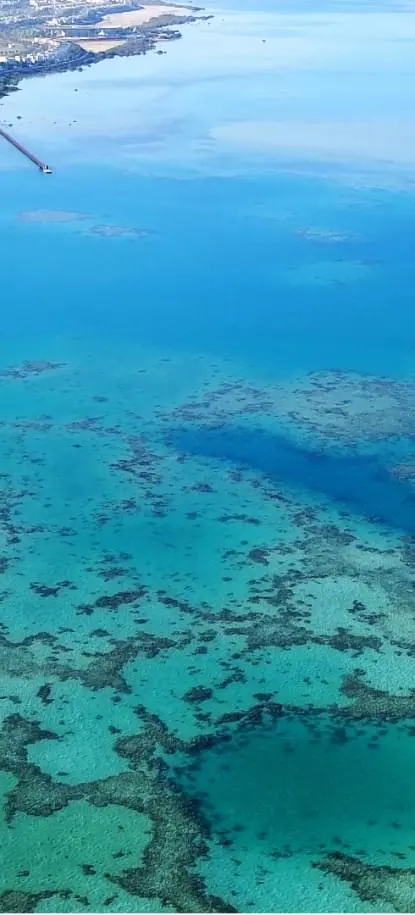




Quick Links:





To conserve, protect, restore and appreciate KAUST local biodiversity and ecosystems, while supporting the Kingdom’s endeavors

At KAUST, beyond the traditional city infrastructure and man-made parks, there is a striking natural terrain and a coastline that host an impressive variety of wildlife and rich biodiversity in our own backyard. Over 250 species of birds call KAUST home throughout the year. For some, the University provides a year-round home, while for others it is a place to rest and feed during their annual migration.
Mangrove forests and other salt-tolerant coastal plants play an important role in protecting coastlines from erosion; they are among the most effective natural habitats for sequestering carbon. Thanks to local conservation efforts, the mangrove forests at KAUST increased by over 45 percent between 2015 and 2021. Today, the University hosts more than 110 hectares (1100,000 square meters) of mangroves.
Around 26 plant species native to the area have been recorded at KAUST. In addition to native flora, there are around 1.3 million square meters of landscaped area, including over 523,000 square meters of public parks, a golf course, lawns and a large quantity of non-native plants belonging to 165 species.
KAUST’s local biodiversity is a part of a global ecosystem that is under pressure from and threatened by climate change, as well as local factors such as new developments and operational practices. As a University of Science and Technology, we have followed and we will continue to follow a science-based approach to improve the local biodiversity value and, in the process, create a model for other communities in the Kingdom and beyond.
Erik Talley, Director
Health, Safety & Environment
Flora, fauna and their habitats provide ecosystem services which are vital to our wellbeing, profitability and sustainability. Although this is widely acknowledged, the United Nations Environment Program (UNEP) acknowledges that ‘despite numerous government pledges, biodiversity loss is accelerating in all regions of the world’.
Environmental protection is one of the key pillars of Saudi Arabia’s Vision for 2030. The Kingdom has highlighted the importance to increasing initiatives that reflect a shared focus on biodiversity across the country and on a global level. Aligning with this, several actions that target the conservation, enhancement and management of biodiversity within KAUST can contribute to halting and reversing the national and global decline in biodiversity, and thus increasing the resilience of our ecosystems that can lead us to prosperity. Moreover, it is expected that the higher the Education Sector is, the greater the importance and impact of its contribution.






The completion of a first stage Environmental Baseline Summary Report summarizes key findings from habitat and species data collected during 2016-2018. Habitat data came from many different sources, including habitat and species surveys. This habitat data is stored in two ‘Habitat Maps’ which cover the entire University estate. The maps, shown above, integrate information on the type and condition of existing habitats, serving as useful tools for us to use in improving habitat states.
This strategy provides an overview of the status of the local biodiversity and outlines a collaborative management and action plan for the future that aims to positively impact the Kingdom and global biodiversity.



KAUST has a rich diversity of ecosystems and wildlife in its terrestrial and marine environments. It is important that all elements of University biodiversity are properly characterized, documented and inventoried. Globally, biodiversity is declining and despite amplified awareness and efforts to mitigate its loss, biodiversity remains threatened mainly by human activities. Acknowledging the threats and pressures on local biodiversity is of high importance. These might include, besides the adverse effects of climate change, the slated physical growth of the University in a biodiversity sensitive areas, the over-exploitation of the natural environment, the use of potentially harmful chemicals and practices for landscaping operations, and the introduction of invasive species and pests.
The goal is about protecting and improving the ecological integrity and long-term viability of the habitats and species identified within KAUST. KAUST can be established as a “living laboratory” where biodiversity conservation and improvement practices are tested and amended, as an integral part of the conservation and enhancement goal.
Within this goal, priority actions would be to restore historic impacts and re-ignite conservation management practices of KAUST landscapes and seascapes, to eliminate or reduce threats to biodiversity, and to reinstate ecological processes. KAUST aspires to be a successful case study and to positively influence not only on a local, but also on a national and international level, for many years to come.
Engaging all community members around campus through a variety of activities (e.g. conservation volunteering, wildlife recording, nature club memberships) will encourage a more individual connection with nature that can enrich human well-being. Engagement will also create a higher sense of ownership, a greater sense caring among people for their surrounding environments. This will help bring together a stronger community spirit. The focus of this goal is to create various engagement opportunities across KAUST and transfer the biodiversity appreciation to the Kingdom and beyond.

